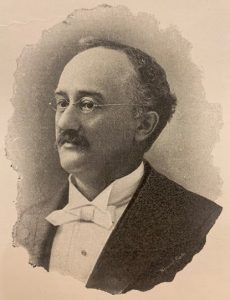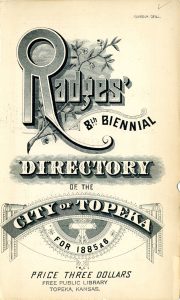Local History: The eccentric life & death of Samuel Radges
If you lived in Topeka between 1869 and 1921, you knew about Sam Radges one of Topeka’s most unusual citizens. He was known as “the directory man.” He was a lifelong bachelor and the perpetual secretary of a Topeka club for liars. Radges once walked up and down Kansas Avenue on the hottest day of the year in a long fur coat, just to prove a point. But one of the most eccentric things about him was arrangements he made for his afterlife.
A pioneer resident

Sam Radges, ca. 1910
Samuel Radges was born in Birmingham, England, in 1843. He arrived in the United States in 1860 on the pretense of seeing Niagara Falls. He later moved to Ohio. When the Civil War broke out, “he obeyed the call” and enlisted in the 74th Ohio volunteers. Radges attained the rank of colonel. After he was honorably discharged in 1865, Radges came west. At first, he settled in Dodge City where he set up a general store and served as the deputy postmaster. Radges later claimed one of his army buddies had managed to persuade President Ulysses S. Grant to give him the position. He only stayed in Dodge City about a year and a half. He moved to Topeka in 1868 or 1869 and began working as an agent for the Merchants Union Advertising Company.
Radges’ Directory

While Sam Radges tended to publish his directories biennially, Radges himself said he would only publish a directory when the town needed one and not before.
The same year he arrived in Topeka, Radges compiled and published the first city directory for Topeka, which was also the first city directory printed in Kansas. Radges' work was not just a listing of local businesses, it also contained the following:
- an overview of the state of Kansas and its “advantages to settlers as a field for emigration,”
- a historical sketch of Topeka,
- a list of Kansas State Legislators,
- and an appendix giving “short historical sketches” of various businesses and groups in town.
The directory soon became a staple for every business and household in Topeka. For the next 50 years, Radges meticulously compiled and published them. Later directories contained illustrations of various buildings in town, articles on Topeka history and a bit of local trivia. He often touted his headcount for residents of the city was as accurate as any state or federal census (if not more so). In 1907, due to failing eyesight, Radges gave up publishing the directories himself. He went into business with R.L. Polk, one of the best known directory men in the country. Polk continued to publish it as the Radges' City Directory even after Sam's death.
Topeka booster
Radges quickly became one of Topeka's biggest promoters. He was heavily involved in helping to start several Topeka institutions. After the library lottery fiasco, Radges was one of the most vocal proponents of creating a city supported free library. When the city council refused to appropriate the necessary funds to open the library, Radges took up a collection to cover the $300 needed.
Radges was also an animal lover. He was rarely seen without one of his beloved dogs at his heels. One of his dogs, Mollie, became almost as well-known as Radges. She was even named one of the mascots of the Topeka baseball team. Radges’ love of animals led him to help found the Foster Humane Society, which later became the Helping Hands Humane Society. Radges was elected the first secretary for the society. He provided them with a temporary headquarters in the office block at 5th and Quincy.
The colonel likes to be odd”
Only a few years after his arrival in Topeka, Radges had made himself a fixture on the list of colorful locals. According to historian Robert W. Richmond, his eccentricities were many but they were never harmful to anyone and entertained Radges and his fellow Topekans. The local Topeka newspapers regularly covered what our genial friend Sam was up to lately.

The Topeka Daily Capital regularly carried tidbits about the odd doings of Sam Radges, including his wearing an overcoat in the middle of July (Topeka Daily Capital, July 29, 1910)
Among his odd interests was the Saint Ananias Club, which he helped found in 1873 and served as the perpetual secretary. The club billed itself as an organization of the prevaricators, fabricators, equivocators and falsifiers of Topeka. According to their bylaws, every man was required to invent at least one new and wholly original lie at each meeting. The club existed until 1907 when it disbanded because there weren't enough members to get a game of whist together.
One of his best-remembered exploits was from the summer of 1910. Radges stated his belief that wearing more clothes in the summer would keep you cool. He reasoned that wearing a coat kept out the heat as well as the cold. His friend Tom King bet him a box of cigars that he wouldn’t make it a block down Kansas Avenue wearing an overcoat “and the rest of the cold weather togs.” Radges took the bet. He paraded up and down Kansas Avenue wearing his overcoat on one of the hottest days of the year.
An afterlife newspaper subscription

After his death, the Los Angeles Evening Express published a story about Topeka's queer old codger, complete with a cartoon of the paper being delivered to his tomb. (Los Angeles Evening Express, February 10, 1921)
Sam Radges was most known for, second only to the directories, was the unusual plans he set up for after he died. At a time when most people didn’t make any arrangements for burial before they died, Radges had a vault constructed at Topeka Cemetery almost 30 years before he passed. He had also communicated precise instructions for his funeral service and burial.
This was so bizarre to Topekans that the Topeka Daily Capital wrote several articles about the preparations and the vault. Completed in June 1895, the vault was made of granite and marble. The paper also detailed the odd provisions Radges had made for when he shuffled off this mortal coil. Radges contracted with John R. Mulvane, the publisher of the Topeka Daily Capital, to have the newspaper delivered to his tomb every morning for at least 20 years. The vault was also wired for electricity and a light was to be kept burning “just over the head plate of the coffin so Radges could read his daily paper even after death.
The man with two graves

The red granite boulder still stands in the Topeka Cemetery and makes find Sam Radges’ resting place incredibly easy. At the feet of the boulder is a large vault cover that simply reads "Sam Radges Sleeps Here.
Unfortunately, Radges outlived his fancy tomb. In 1904, Radges sold his vault to an undertaker who asked him for the use of the vault to bury Bertie Easter Fisher, whose dying request was that her remains be placed in the Radges vault (newspapers neglected to say why).
A few years later, Radges was able to arrange for a one-of-a-kind resting place once again. A group of Washburn students found a large granite boulder on a farm about six miles southwest of Topeka. Radges purchased the 13,000 lb. stone and arranged for it be carted by a team of six horses to the Topeka Cemetery.
One of the Most Interesting Characters in the State is Dead
Samuel Radges died on January 5, 1921, at the age of 78. His directions for his funeral were carried out to the letter, with both a Scottish Rite Masons’ Rose Croix service and a Grand Army of the Republic service included.
![]()
Newspapers across the country carried the strange tale of the man who wanted the paper delivered to his grave (Wichita Beacon, January 21, 1921)
Radges was buried in front of his red boulder gravestone. Wanting to stand out, even in death, Radges’ grave was slightly off kilter from the rest of the cemetery. Radges discovered the Topeka Cemetery graves weren’t laid out precisely east to west, and he wanted to make sure his was.
Faithful to his instructions, the Topeka Daily Capital was delivered to his grave every day for several years. Newspapers across the country and in Canada carried the story of the odd man from Kansas who wanted to read the paper even after he was dead.














